

CAMPUS | Winter 2023 | 1 38 Sustainability seen Visible sustainability efforts improve opinions 8 Industry News The latest news and views on campus 30 Whats on the menu Countering rising food costs on your campus 42 Protecting night-work Winter maintenance can be made safer Sustainability masterplan Sustainable living in a campus context Winter 2023
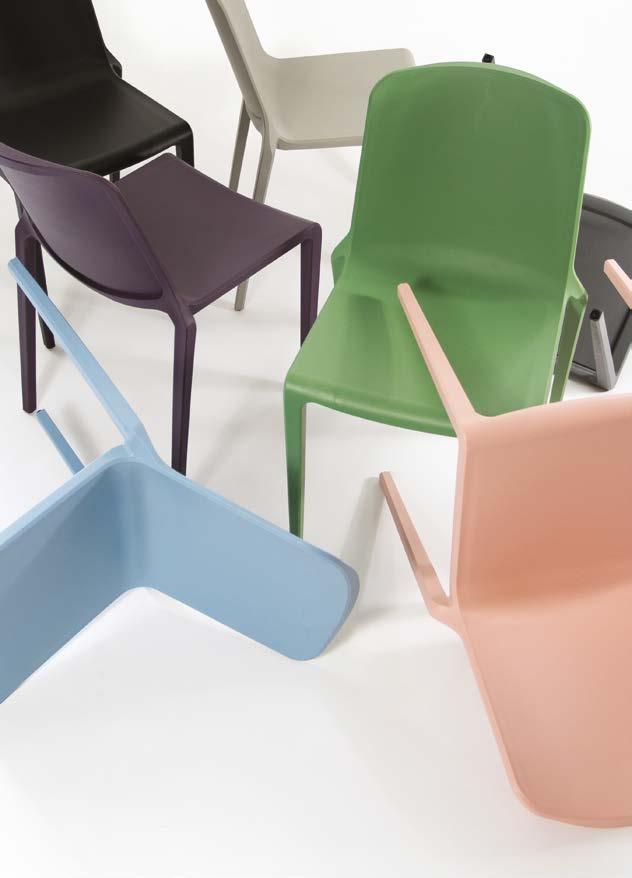
Made in the UK kieurope.com info@kieurope.com 020 7404 7441

Editor Chris Hewett editorial@mebmedia.co.uk
Accounts Jay Kempisty accounts@mebmedia.co.uk
Publisher Wayne Banks +44 (0)1622 201207 wayne.banks@mebmedia.co.uk
Website and Circulation Manager Kevin Villa website@mebmedia.co.uk
Design and Production Charles David production@mebmedia.co.uk
Campus Estate Management Magazine is published 4 times a year by MEB Media Publishing Ltd 13 Princes Street Maidstone Kent ME14 1UR United Kingdom Tel: +44 (0)1622 201207, info@mebmedia.co.uk www.mebmedia.co.uk
Articles and art may not be reproduced or reprinted without the express written permission of the publisher.
Exclusion of Liability
Although every effort will be made to ensure the accuracy of all materials published, the publisher takes no responsibility for errors or omissions.



Copyright © MEB Media Publishing Ltd 2023, all rights reserved. 38

4 Sustainability masterplan
Sustainable living in a campus context
8 Product & Industry News
The latest news and views on campus
22 Managing student access
The management of access control in higher education is complex
26 Legionella risk in RAAC affected buildings
Water hygiene consequences of using RAAC
30 Whats on the menu
Countering rising food costs through your food offerings
34 4th emergency service
AUCSO talks about the biggest threats to security
38 Sustainability seen
Visible sustainability efforts may improve opinions
42 Protecting night-time workers
OUTCO discusses how challenging work like winter gritting can be made safer
CAMPUS | Winter 2023 | 3
26 22
Contents

Sustainability masterplan
Sustainable living in a campus context by Michál Cohen and Ailsa Forsyth, Walters & Cohen
Architects
In his book ‘The Nine Elements of a Sustainable Campus’, Mitchell Thomashow discusses three main strands: infrastructure (energy, food and materials); community (governance, investment and wellness); and learning (curriculum, interpretation and aesthetics). Architecture impacts on all three strands, and we believe your built environment can be seen as a showcase for your institution’s
attitude towards sustainability. One of our newest clients is an Oxbridge College: they’ve commissioned us to create a masterplan led by sustainability in its broadest sense, and we’re finding the consultation with students and staff very inspiring. It is evident that students feel passionately committed to the planet, and those running campuses are listening. For instance, CLOC is an initiative
by students who have devised a Climate League of Oxford and Cambridge, giving colleges a rating along the lines of A level grades. And universities are becoming ever more transparent with their sustainability reports, specifically about how they are tackling sustainability in their building programmes. To take just two examples, the University of Manchester has a Campus Masterplan website, and the
4 | Winter 2023 | CAMPUS COVER STORY
University of Nottingham website shares information about their current building developments.
The wider lens for universities is making sure that whatever they’re offering is sustainable in terms of continuing to operate well, being the best the institution can be, and attracting students and staff by being seen as a desirable place to work, live and study. Our clients know they have to consider the well-being of everyone on campus: people have such a wide range of needs, and your physical environment can help with issues around inclusion and diversity. As a minimum, the campus should be physically accessible, but we can go beyond that to provide a variety of environments – indoors and out – so that everyone can find a place where they feel safe and comfortable, from the group that wants an enthusiastic debate to the person who needs a quiet nook to themselves, and everyone in between.
Students are also keen that that their institutions invest ethically. This is a big move and clearly it’s not going to happen overnight, not
least because of fears that if you invest ethically, you’re not going to get the returns you want. However, The Times reported in June 2022: ’There is no evidence that ethical funds underperform, in fact a number consistently beat many of their nonethically screened peers.’ No doubt universities are keeping a close on eye this.
From our perspective as architects, we’re currently looking at two main strands with our client: the building of the campus, and the running of the campus. The former is self-evident; the latter includes big items such as energy use, and many details like the cleaning products you use, how everything is sourced, and how far things have to travel to be delivered. We’re discussing the impact of meat-free days on the university’s carbon footprint, and ideas like encouraging students to limit Amazon deliveries to certain days of the week, avoiding the sometimes dozens of daily deliveries.
In mitigation, one student pointed out that Amazon are electrifying their fleet, which brings us to
decarbonisation. Last year National Grid ESO reported that the country’s electricity system is ‘on track to be powered free of fossil fuels and at 100% zero carbon in just four years’ time’. The BBC reported in April 2022 that the UK’s 11,000 wind turbines produce ‘nearly a quarter of the UK’s electricity’. This is very positive in terms of how we think about the refurbishment of buildings. A services engineer recently told me that seven or eight years ago, in order to make the desired carbon saving on refurbishment projects at Oxbridge Colleges, a lot of work was needed on the fabric of buildings to get the benefits we can now get thanks to the decarbonisation of the grid. That said, there are other very sound reasons for paying attention to the building fabric: the comfort of users is greatly improved if you fix leaky roofs, double-glaze windows where possible, make sure there are no air leaks, and get the right insulation into walls and roofs. All of this can be difficult if you have a listed building, but it’s important to make sure people are happy in their

CAMPUS | Winter 2023 | 5

environment.
The students we’re speaking to are keen to do their bit for the environment. They’ll recycle and compost where those facilities are available, and many are comfortable with re-using – they’d welcome formal set-ups for pooling, lending and buying used goods. There’s a good understanding that reducing and re-using are environmentally preferable to recycling.
We’d love to explore ways to connect students to their energy and water consumption: if you’re paying a flat fee to live in halls, you might not be thinking about what happens when you have a long shower, or leave your heating on while you go out for the day, or perhaps have your radiator on and the window open. A smart BMS (Building Management System) can flag up things for investigation, for example a building that’s using a lot of energy even though it’s empty. If you can spot that and close the windows and switch off the lights and heating from a central hub, you’re saving resources.
There’s a great deal of potential
outdoors too: how people use the outdoors can have positive effects on their well-being, and biodiversity has a much greater impact on your sustainability credentials than you might think. Often driven by students, a number of Oxbridge colleges are moving away from having manicured lawns everywhere, giving some of their outside spaces over to rewilding, or sowing wildflowers.
There’s so much to cover, but for brevity we’ll finish with some of the questions we are talking about with our clients:
• What can you do to encourage good sustainable habits, to make it effortless?
• Can everyone see what energy they are using, and can they control that?
• Is recycling and composting easy?
• Can you store your bicycle safely?
• Is the campus big enough to warrant a bike-sharing scheme, including e-bikes?
• Are your caterers able to plan so as to avoid food waste? Can you have meat-free days?
• How can you use your existing
facilities to the max, before building anything new?
• Are your acoustics as good as they can be? Are people able to talk and hear comfortably?
If you have an architecture department, or are offering other relevant courses, what are they teaching their students, and are those departments collaborating?
Architects are curious by nature: we want people to be happy and comfortable in their environment, and doing that from a sustainable perspective is front and centre. If you want to create a sustainable campus there’s a lot you can consider, and there are links everywhere you look. A masterplan is a golden opportunity for planning charging points for electric bikes and scooters, putting in a repair shop, making a biodiversity corridor, and – above all else – getting the dialogue going so that everyone is aware of what is happening, everyone is heard, and the goal of being a sustainable campus becomes a shared responsibility.
6 | Winter 2023 | CAMPUS
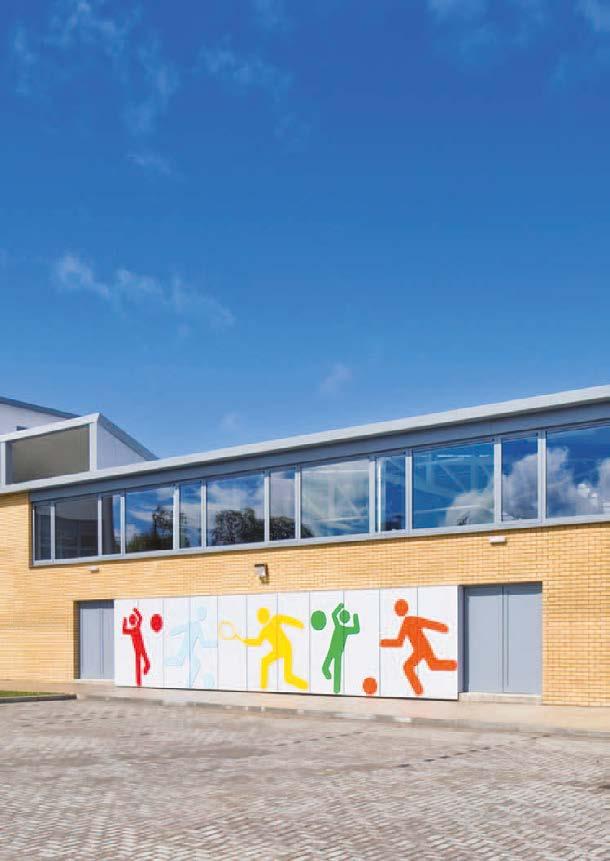
Bosch Commercial and Industrial Heating Solutions for education facilities

£7m construction on state-of-the-art SEND school completes in Ipswich
THE newest SEND school in Ipswich – Woodbridge Road Academy - has held its official opening ceremony, following the completion of work on site in Russet Road.
The £7m new-build school is tailored for 60 children and young people with special educational needs and disabilities and has been constructed under the Department for Education’s (DfE) MMC1 framework.
The school features 12 classroom suites and several learning resource areas, which will allow secondaryage pupils to be taught vital life skills. In addition, Woodbridge Road Academy boasts a well-equipped library, sensory rooms, main hall, dining area, and accessible bathrooms. Outside, a multi-use games area (MUGA) has been constructed for recreational activities – including use by the wider community.
Beyond serving the student population, the layout of the school allows specific areas to be accessed by the community outside core school hours. This includes the main hall, accessible bathrooms, hygiene rooms and the outdoor MUGA, meaning that the wider community also benefits from the new facility. The design also incorporates a ‘community lock’ feature, with Salto door lock systems on certain doors meaning that access to particular areas can be controlled by the school, providing additional levels of flexibility and security.
Architecture and interior design teams from multidisciplinary construction consultancy Pick Everard have worked closely with design and build contractor Bowmer + Kirkland, playing a pivotal role in delivering a carefully considered design fit for both pupil and community use.
Paul Knifton, director at Pick Everard, said: "As with any school project with a variety of stakeholders, collaboration was at the heart of this project's success. We are pleased to have worked with Bowmer + Kirkland and Woodbridge Road Academy to create a new, purpose-built building that will transform the SEND provision in Suffolk.
“This collaborative approach saw our team of specialists attending design meetings across all disciplines, making sure that compliance with MMC1 specifications was upheld. Through engagement with the academy, which started in March 2021, we were able to together successfully deliver designs that were operationally robust while also meeting specific needs.
“Close proximity to the nearby rail track also required careful consideration, so the building itself has been strategically positioned to ensure minimum noise and vibration from passing trains – and additional elements have been added for student safety, such as tall fences.
“We’ve been very pleased to bring our extensive experience from other MMC1 framework and SEND projects, ensuring the best use of project budgets and gross internal floor area (GiFA). This expertise and our collaboration have resulted in a school that not only meets, but exceeds the stringent requirements needed for SEND schools – and adds values to pupils and the community too.”
For more information on Pick Everard and the services it provides, visit: www.pickeverard.co.uk.
8 | Winter 2023 | CAMPUS PRODUCT & INDUSTRY NEWS
Battery and solar is a winning combination for education centre

Adding battery power to a building’s solar array is helping a higher education centre to cut carbon emissions and costs.
The University and Professional Development Centre (UPDC) in Bury St Edmunds, Suffolk, offers degree courses and adult education services. It recently installed 500 kilowatts (kW) of rooftop solar, with support from West Suffolk Council. The estates team at UPDC, part of the Eastern Education Group, sought to ensure that it could maximise use of the renewable energy generated by the rooftop array, with an energy storage system to capture the surplus solar.
Andrew Swift, Group Director of Estates for Eastern Education Group, said: “This is a large building, which was a former warehouse and engineering facility, so it takes a great deal of energy to run. The campus is functional all year round and generally for long hours on most days.
“When energy prices escalated our bills increased threefold, so it became a priority to reduce them. West Suffolk Council supported us with the solar installation, as we wanted to optimise our use of renewable energy and the sustainability it would generate for the college. We were already informed of battery energy storage systems and approached Connected Energy to find the right solution for us.”
Energy storage specialists Connected Energy carried out a feasibility study to demonstrate the savings that the Group could make by adding an energy storage system to support the solar array. Connected Energy recommended and installed one of its 300kW E-STOR
units.
“E-STOR enables us to store excess energy from the solar panels and draw down on it during peak periods of demand, rather than directly from the grid,” added Andrew. “Combined with the solar array we estimate that it will offer us considerable savings annually with our energy costs.”
The Eastern Education Group provides further, higher and adult education services across the East of England, namely Suffolk, Norfolk, and Cambridgeshire. The Group has also installed EV charge points across its estate and is in the process of replacing its carbon fuelled fleet for energy efficient alternatives. “Vehicles that utilise the charging stations at UPDC can do so in the knowledge that the power source to them is provided by renewable energy from the solar array and energy storage system,” said Andrew.
Connected Energy takes batteries from end-of-life electric vehicles and gives them a second life in its E-STOR energy storage systems. This means that E-STOR offers increases sustainability benefits compared to a system that uses new batteries.
“If this installation works as well as we anticipate, we will look at installing further energy storage systems in tandem with rooftop solar arrays across the Group’s estate,” added Andrew. “Sustainability is a priority for the Group, we are committed to several of the UN’s sustainable development goals and are exploring more options for capital investment to further reduce the carbon footprint of every campus in our portfolio.
CAMPUS | Winter 2023 | 9

Celebratory event as new primary school comes closer
Willow Grove Primary School in Wixams has come a step closer to opening following completion of the school’s foundations.
The new school is set to be open next September on a 3.4 hectare site in the future town centre, and will be part of the Kingsbridge Educational Trust.
A special celebratory event to mark the landmark was held in November, where Bedford Borough councillors toured the site to see the progress so far.
The first cohort will be 25 reception children, 25 Year 1 and 25 Year 2 pupils, but in time the school will expand to be four-form entry with 120 children admitted each year and 840 pupils across the school.
Pupils will be able to enjoy high-spec purpose-built new classrooms, a large hall, library, specialist rooms, playing fields with a range of sports provision, and car parking for staff and visitors.
Wixams already has two existing primary schools and a secondary school, with demand growing as the population expands. Wixams is expected to become the third largest settlement in the Borough, after Bedford and Kempston.
Councillor Jane Walker, portfolio holder for family, education and children's services at Bedford Borough Council, said; “Willow Grove will be a key part of Wixams for generations to come, making it very exciting to see the vision being brought to life.
“This school will be at the heart of a new community
with children who only deserve the best. We are determined to do everything we can for their future.”
Councillor Hayley Whitaker, executive member for families, education and children at Central Bedfordshire Council said: “Central Bedfordshire Council is honoured to have contributed half of the funding for Willow Grove Primary.
“From September, it will serve as a cornerstone of the Wixams community and, straddling the boundaries of Central Bedfordshire and Bedford Borough, it symbolises the two councils’ shared dedication to providing quality education to children.
“Together, we have taken significant steps towards shaping education for young people in this part of Bedfordshire, which will help forge a future where children can thrive, learn, and grow.”
Sean Conneely, director at Pick Everard, said; "We're proud of the collaboration that will help fulfil the educational needs of pupils in the area, as well as the significant value the project will deliver to local communities too.
“Having provided project management, cost management, NEC supervisor, health and safety services, it's a perfect example of a scheme that underpins our ethos to deliver better together and we look forward to continuing our collaboration with the wider team as the next build phase progresses with completion in August 2024."
10 | Winter 2023 | CAMPUS


500 One of the most versatile work utility vehicles on the market, the Carryall 500 has the power to replace pickup trucks at a fraction of the cost. With a rustproof, aircraft-grade aluminum frame, and cargo box, along with best-in-class ergonomics, the Carryall 500 is the perfect solution for your industrial and commercial jobs. DO YOUR BEST WORK www.clubcar.com info@clubcar.com

Growth in moveable walls for university lecture theatres
Demand for moveable walls from universities has grown in recent years with many looking to modify their lecture theatres to create more adaptable space.
Michael Porter, Style’s group sales director reports that large lecture theatres are often underutilised with only a single class being taught at any one time.
“Universities regularly find their lecture theatres are only filled to 50% capacity or less,” said Michael. “For this reason, we have seen a rise in demand for moveable walls that can cope with a stepped lecture theatre or very large, high-ceilinged rooms, enabling staff to rapidly divide the space into two separate lecture theatres and run concurrent classes, thanks to the high acoustic divide.”
Style is UK’s leading moveable wall specialist, involved with many universities which have benefitted from the installation of either a vertically rising moveable wall, or a horizontally sliding wall, both which can be moved into position to sub-divide a lecture theatre into two entirely separate rooms.
At Strathclyde University, Style installed a Skyfold Zenith stepped moveable wall with an outstanding 59dB acoustic rating, which descends from the ceiling at the push of a button. A similar Skyfold was also installed at Glasgow University.
At Loughborough University, a vast 57dB Dorma Huppe Variflex ComfortDrive moveable wall was installed by Style, with fully automatic operation that ran via a dedicated channel in the centre of the room.
At the push of a button, the operable wall glides effortlessly into place to enable separate lectures to be hosted either side without disturbing one another. An integrated pass door provides access between the divided rooms so that the wall can remain in place for long periods of time if desired.
Other examples are at The Frederick Douglass Centre at Newcastle University, the lecture theatre at Oxford Brookes and also at Coventry University.
for further information visit www.style-partitions.co.uk
12 | Winter 2023 | CAMPUS
Cerberus PRO – a guarantee against false alarms

Siemens continues to focus on eradicating false alarms through its patented ASA (Advanced Signal Analysis) detectors which provide unparalleled detection response and false alarm immunity.
With the new policy introduced in 2023 by the Scottish Fire & Rescue Service (SFRS) whereby they will no longer attend automatic fire alarm call outs to commercial business and workplace premises unless confirmation of a fire has been provided, the need to reduce false alarms and continue to build confidence in automatic fire detection (AFD) systems has never been greater.
The Siemens ASA technology enables its partners to install smoke detection in areas where thermal detection would ordinarily be necessary. Crucially, it also offers a guarantee against false alarms.
The ASA detectors are part of the Siemens Cerberus PRO comprehensive EN54-13 approved fire alarm system. Under its ongoing commitment to its ‘Smarter Protection Matters’ philosophy through which the company’s offering is constantly being developed, Siemens is now on the IP8 version of Cerberus PRO.
Higher power
One of the central features of the new IP8 version is the introduction of a 1.5A per line high power driver which, importantly, allows more devices to be installed on a single loop, increasing flexibility and improving efficiency. Compared to the previous capacity for the number of EN54-23 devices possible, the new IP8 loop cards can accommodate more than double. While the majority of addressable systems are wired as a loop, some may have spurs. The Cerberus PRO system can also support this, up to a maximum of 40 spurs per loop. The Siemens development team responsible for IP8 have worked hard to optimise efficiencies which, despite
the increase in power, has resulted in smaller batteries and housings.
Disturbance-free testing
Another feature of the Cerberus PRO IP8 system is the disturbance-free function testing (DFT) capabilities. Through remote services, maintenance can be simplified and business interruption minimised with monitoring and periodic testing of devices undertaken off-site. This is across devices on the system, from detectors and voice messaging to sounders and beacons. Silent load testing and activation of the devices which are unnoticeable to occupants also help to further reduce any impact on day-to-day operations, particularly in busy public and commercial buildings.
Many of the checks can be performed automatically without the need for any human intervention. For example, detectors, sounders and beacons can be configured to conduct disturbance-free function tests every 24 hours, emitting a very low level of sound and light invisible and inaudible to the human senses. If a fault is identified, an event is sent to the control panel which is visible through the Cerberus PRO cloud apps. This regular testing also ensures that on-site service visits can be planned with more information available in advance, allowing any specific issues to be addressed with prior knowledge.
Open Protocol
Cerberus PRO is an open protocol system, allowing other systems such as building management (BMS), CCTV and access control to be easily integrated.
For further information on Siemens Building Products please visit www.siemens.co.uk/cerberus.
CAMPUS | Winter 2023 | 13

Forbo helps to create a fresh and welcoming appearance for prestigious university department
The School of Geography and the Environment at the University of Oxford, one of the country’s most historic universities, sought to update its flooring. With the existing floor coverings having become worn and dirty, the university department turned to Forbo Flooring Systems’ integrated portfolio of barrier matting solutions, Nuway and Coral, to create a better first impression for students, staff and visitors.
Based within the University of Oxford’s Social Sciences Division, the School of Geography and the Environment is recognised as a dynamic and diverse academic department. However, following years of heavy foot traffic, the flooring in the building’s reception had deteriorated in condition, leading to the decision being made to replace it.
With over 3000 students, staff and visitors entering the building every week, it was essential that an effective and resilient entrance flooring system was specified and installed. Lorna Softley, Head of Planning and Projects at the School of Geography and the Environment explained: “As a busy department, we were conscious that we needed a durable flooring system for this main throughfare into the building, one that could withstand the heavy footfall we expect per day. This was something that drew us to Forbo’s entrance flooring solutions, as we knew they could deliver on the functionality we required, ensuring levels of walked-in dirt and moisture were reduced.”
However, it wasn’t just the functionality that the department were concerned about, with Lorna saying: “As the previous carpet had become really worn down, we wanted to go in and replace it with a contemporary, patterned and multi-tonal carpet. We wanted the new floor coverings to contrast with the original plain grey flooring and bring a more energetic and vibrant feel to the reception space.
“We were presented with options from a few different suppliers but Forbo’s stood out to us, with the wide variety of colours, patterns and textures across its Nuway and Coral entrance flooring ranges. We wanted a solution that wasn’t too dark in colour, to avoid it getting discoloured or marked, but also light enough to ensure the entrance felt open and welcoming.
“With this in mind, we specified Forbo’s Coral Interior in the Ocean Spray colourway directly inside the entrance and in the surrounding reception and stairwell areas. As we were only replacing part of the overall interior carpet, we had to make sure the new flooring would complement the existing floor coverings. We considered blues and greys, but eventually settled on a mix of blue hues with some darker black tones. This gave us the best balance between our aesthetic and practical requirements.”
Find out more about Forbo’s entrance flooring solutions, here.
14 | Winter 2023 | CAMPUS
NEXT GENERATION KEYLESS ACCESS CONTROL
Smart access control technology platform designed to give users ultimate freedom of choice regarding system layout, type and number of access points as well as level of security.

TOTALLY WIRE-FREE: Stand-alone, virtually networked, wired and wireless smart locks, all working within a single access control technology platform.
BUILT TO COVER EVERY ACCESS POINT: Extensive range of electronic locks, cylinders and readers to cover all the needs of any type of building.
EASY TO INSTALL: Designed to be installed in doors with existing locks, with no need for additional modifications or wiring.
SECURE KEYLESS ACCESS: Complete mobilecompatible electronic locking platform, increase in security, control and convenience.

SALTO Systems LTD - United Kingdom +44 01926 811979 I info.uk@saltosystems.com I www.saltosystems.co.uk

Combining safety and aesthetics at new Dutch academy
When it comes to constructing schools, colleges and universities, it’s important to balance aesthetic design with building safety. It's about creating spaces that are not only safe and functional but also welcoming and inspiring for both staff and students. The new Academy Tien in The Netherlands strikes this balance perfectly, with Pyroguard’s fire safe solutions playing a pivotal role throughout.
Designed by Wiersema Architecten and de Architecten CIE, the Academy Tien is a beautiful new school building near the centre of Utrecht. Catering for students between 10 and 18 years old, the academy has been constructed with a contemporary open plan layout, to maximise the building’s natural light transmission.
Contracted to deliver the fire-resistant steel interior partitions and frames on the project, was JM Van Delft & zn, a specialist in glazing system solutions. Ruud van Dal, Sales and Operations Manager at JM Van Delft & zn, said: “Throughout this project, it was important that both aesthetics and safety were considered and well balanced. There was a clear requirement for keeping the school’s interior spaces light and open, while simultaneously providing a safe environment for students, staff and visitors to work and learn in. As a result, fire safety glass was chosen as the perfect material for installation within the building’s internal partitions, doors and central atrium.
“Pyroguard Protect EW60 was installed within the doors, sidelights and designated escape routes.
While Pyroguard Protect EI60, offering the highest level of protection, was installed between classrooms and the central atrium, creating a series of fire safe compartments.”
This process of compartmentation can form a key part of any building’s passive fire protection strategy, working to split the building up into a series of fire safe zones. As well as helping to limit the spread of a fire, this can also provide both a safe route of escape for occupants and a means of entry for the emergency services.
Ruud continued: “Pyroguard Protect’s high visual appearance helped to maintain the light and open interior that the architect desired, while its multifunctional capabilities proved key in delivering improved acoustic control and impact resistance - something which was a clear priority when designing the new academy.”
Pyroguard Protect is a toughened fire safety glass, certified for use in steel, timber and aluminium profiles. Providing 30 to 180 minutes of protection against smoke and flames, 1B1 impact resistance, and UV stability, Pyroguard Protect ensures that both design and safety requirements can be achieved.
The Academy Tien opened its doors to students in January 2024.
For more information about Pyroguard, please visit: www.pyroguard.eu
16 | Winter 2023 | CAMPUS
Marshall-Tufflex launches new desktop power and data module
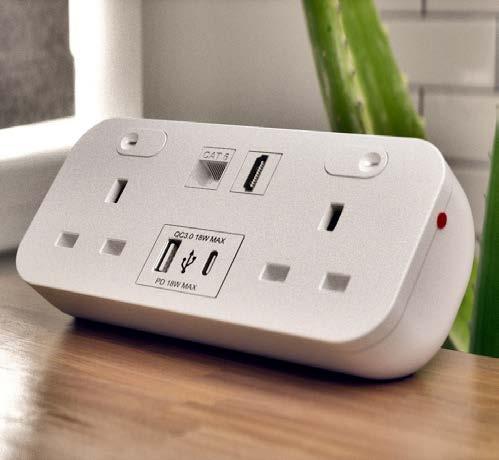
Marshall-Tufflex has expanded its range of underfloor to desk solutions with the launch of the modern and versatile Icon Desktop Module, ideal for small offices, home offices and educational facilities.
The new Icon Desktop Module, available in black and white, contains two individually switched UK power sockets and integral USB A and USB C charging ports as standard. In addition, there is the option to purchase the Icon module with two Cat-6 data ports, Cat-6 and HDMI ports or with blanks, if data and multimedia connections are not required.
The Icon Desktop Module has been designed with an angled face surface to allow easy access to the sockets and ports and is fixed securely to the desktop using the G clamp supplied with the product. The Icon Desktop Module also includes resettable thermal fuses and complies with the BS6396:2022 standard.
The latest product joins Marshall-Tufflex’s underfloor
to desk portfolio which includes a comprehensive range of flexible underfloor cable management and prefabricated wiring solutions, as well as power and data modules for both desktop and under-desk mounting.
Commenting on the launch of the new product, Martin Russell, Group Product Manager at MarshallTufflex said: “The stylish, modern and compact Icon Desktop Module is an important addition to our range as it provides an option for an even wider variety of applications including the small office/home office (SOHO) market. With different options available for data and multimedia connection the Icon Desktop Module can meet various customer requirements.”
To find out more about the Icon Desktop Module and the rest of the Marshall-Tufflex underfloor to desk range visit www.marshall-tufflex.com
CAMPUS | Winter 2023 | 17

Automatic door servicing solutions from TORMAX

With wet and windy weeks ahead, it is important to regularly service your automatic entrance system to ensure it continues working at optimum efficiency, whatever the weather throws at it.
With a nationwide team of in-house trained engineers, TORMAX can deliver a full service and maintenance programme, or one-off emergency repairs, for almost any automatic door.
“At this time of the year it is especially important to schedule a service call to make sure your automatic door remains legal, safe and fully operational at all times,” explains Simon Roberts, MD for TORMAX UK.
“A build-up of debris, dirt and leaves, or an ingress of water during heavy rainstorms, can affect the performance of the system or even cause the door to fail entirely.
“A comprehensive service call-out can quickly pick up any potential problems, avoiding long-term damage to the system whilst also providing timely maintenance to maximise the performance of key mechanisms.”
Offering a cost-effective solution, TORMAX offers a Planned Maintenance Contract (PMC) with timely call-outs scheduled throughout the year, minimising the chance of inconvenient down-time of the system.
TORMAX is a division of the LANDERT Group, a Swiss-based manufacturer of automatic pedestrian and industrial door systems with over 500 distributors across the globe. Committed to providing exceptional service with highly qualified technical advisors and engineers, TORMAX has been a market-leader in the UK for more than 60 years.
CAMPUS | Winter 2023 | 19

Newcastle university enhances utility fleet with two goupil G4s
Newcastle University has bolstered its fleet of utility vehicles through procuring two Goupil G4s from the UK’s leading electric utility vehicle supplier and manufacturer, Bradshaw EV.
The vehicles have been acquired by Newcastle University’s Grounds Maintenance team, where they will utilise the Goupils to help manage and maintain the campus’ green spaces throughout the calendar year. In order to facilitate this, both vehicles have been customised with a cage tipper attachment.
Available as pick-ups, vans and waste collectors, the Goupil G4 is designed to provide total versatility. With an operational range of up to 101 miles, a 1200kg payload and a maximum speed of 31mph the G4 is purposefully designed with a variety of body types and features a safe and secure cabin with both left and right hand drive options.
The Goupil G4 range also provide an environmentally friendly and sustainable solution for organisations looking to reduce their carbon footprint while similarly being able to be adapted to the specific requirements of the customer.
With Newcastle University setting its sights on reaching Net Zero by 2030, the decision to purchase the all-electric Goupil G4s has come at a time where the institution is accelerating its sustainability pledges. Having previously used a Ford transit to embark on its ground maintenance work, which did not comply with the city’s recently introduced Low Emission Zone, the need to find a compliant solution to avoid costly charges was also a key in the decision-making process for the
University.
Tom Vasey, Grounds Manager at Newcastle University commented: “We were delighted to take delivery of our two Goupil G4s featuring Bradshaw’s cage tipper attachments. The vehicles have been procured to help us provide a more seamless solution to our grounds maintenance work, as with much of the campus now pedestrianised and located within Newcastle’s newly introduced Low Emission Zone the transit van that we originally used simply was no longer suitable.
“Following the introduction of 20mph zones throughout the city and the low-speed nature of the operation on campus, the continuous low RPMs would lead to a number of issues with the transits. Therefore, given the nature of the operation a battery powered vehicle was considered a more appropriate option in terms of ensuring vehicle uptime.
“As the University has ambitious aims of becoming carbon neutral by 2030, we also wanted to find a solution that helped contribute towards this allimportant goal through procuring a vehicle which was emission free.
Tom continued: “While we trialled a number of different vehicle options, once we came across Bradshaw’s Goupil range we felt that it ticked several boxes and more. Its compact size and low speed meant that our grounds operatives could seamlessly navigate through the pedestrianised areas of the campus without endangering pedestrians and its aesthetic was unanimously preferred by our team members.
20 | Winter 2023 | CAMPUS


Managing student access
The management of access control in higher education is complex. Paul Brady, HID’s End
User Business Manager for Physical
Access
Control looks at how smartphone-based solutions can solve day-to-day operational headaches and deliver real future value.
As demand soars in higher education, managing student access must go mobile and smart
It’s boom time for higher education in the UK. Over 2.86 million students are enrolled in courses at the moment[1], with the demand for places high despite the disruption caused by the global coronavirus pandemic and impact of Brexit. At the end of the 2022 admissions cycle, around 767,000 applications from UK and international students were
received through UCAS for full time undergraduate places, with 560,000 people accepted by universities and colleges. This set a new record.[2] The forecast is bullish, too. Commentators estimate 30%+ growth with circa 1 million students applying by 2030[3] – an optimistic prediction which they say is on track especially given ONS data shows a significant increase in the 18-year-old population cohort. This is clearly excellent news for the 277 colleges and 166 universities which make up the UK’s higher education sector.
Such growth presents a whole raft of operational challenges for institutions, not least about how to manage student access—efficiently, effectively and securely—when on campus.
This is complex as anyone working in a higher education IT, security services or estates departments will know. One of the primary challenges is the sheer size of institutions given universities and colleges often have sprawling campuses with numerous buildings, each serving diverse
22 | Winter 2023 | CAMPUS
ACCESS CONTROL
functions.
Managing physical access across this expansive landscape demands security infrastructure which is comprehensive yet flexible. The user base adds another layer of complexity. Students, faculty, staff and visitors each have their own access needs, dictating a nuanced approach to control.
The transient nature of the academic community presents another obvious problem, too. New students arrive, others graduate and faculty members move on. Managing credentials, ensuring timely updates, and revoking access for those who no longer need it requires a streamlined and responsive system. Failure to do so can result in breaches and security gaps.
Using smartphones for access control
A practical way to address these issues is to transition away from using physical plastic access cards— which utilise RFID technology—to smartphone-based solutions running on any iOS or Android device. These leverage virtual credential technology connecting to mobileenabled door readers to allow people to enter.
Mobile access solutions deliver a raft of benefits for institutions, staff and students:
• Wireless credentialling. Softwarebased management running in the cloud makes it straightforward to
deal with the licensing, allocation of virtual credentials, setting of building access rights, validating or revoking of IDs—all remotely. The upshot? Mobile access makes life far easier for time-pressed staff as systems are much simpler to manage and use. This is especially the case at peaks times like September, when student enrollment can be done at a touch of a button rather than IDs having to be posted or people having to stand in queues for them. A student simply gets an email to their phone, they tap on a link, the app automatically uploads and a mobile credential is granted.
• Time and attendance. Institutions can introduce time and attendance monitoring to ensure students are attending lectures. It’s simply ‘tap and go’ on a reader leveraging the Bluetooth technology in a smartphone. This provides campus data on whether students are actively taking part in their courses, as well as addressing duty of care issues.
• Enhance the student experience. By integrating access control with digital campus cards, institutions can augment the whole student experience in what is an ever-competitive education sector. Students then have everything they need in the palm of their hand: a tool to access buildings such as libraries, halls of residences and gyms, as well
as other services like printing, vending machines, car parks and so on.
This makes the life of a student far easier, boosts their well-being through secure technology, with the universities and colleges who have implemented such solutions seen a pioneering in terms of how they are improving the working environment. In addition, the use of campus apps means better outbound communication. For example, health and safety announcements, student discounts and offers, promotional campaigns from brands, along with updates about events and lectures. The smartphone in effect becomes the primary interaction tool between the institution and the student— important given Gen Z digital native students expect institutions to provide this type of solution anyhow.
• Integration isn’t hard to achieve. Products that are interoperable and support industry standards are available. Using open APIs and software development kits, integration is simplified, enabling institutions to create a modern ecosystem whilst avoiding vendor lock-in.
• Seamless and straightforward transitioning. To implement mobile access, door readers first need to be checked. The latest models support mobile access out-of-the-box. Others can be upgraded [really old ones have

CAMPUS | Winter 2023 | 23

to be replaced]. It’s then just a case of obtaining and installing the mobile access solution—a smartphone app and server-side tools—and integrating this with whatever building management or security systems are in place.
Many readers support both physical RFID cards and virtual credentials so staged roll outs are possible. This is ideal where a ‘big bang’ switchover would be too complicated or costly. It should be noted that the latest credential technology—irrespective of whether it’s on a card or phone—can’t be copied either by a student buying a cheap cloning device online.
• Touch in and out for fast access. With support for both Bluetooth and NFC[4]—two technologies enabling data transfer over short distances—mobile access solutions provide touchless entry just like traditional physical cards. This makes it as fast for everyone to open doors.
• Enhanced security and safety. Mobile-based credentials and door readers support the latest encryption, communications and authentication standards just like physical access cards. Mobile has other security benefits. First, users—even students—take far more care looking after their expensive smartphones compared to plastic access cards. Each time one is lost, it creates a security risk. Second, if someone does
indeed lose their smartphone, they'll clock this far quicker (who can function without a phone these days?) with their digital credential then able to be quickly disabled wirelessly. It is this remote management capability which is so fundamentally better.
• Environmentally friendly. It is estimated that more than 550 million PVC access cards are made and sold annually each year, creating 2,700 tons of plastic waste and emitting 11,400 tons of carbon emissions. Digital credentials remove this damaging environmental overhead in one fell swoop.
• Big cost savings. The migration away from plastic RFID access cards presents institutions with a real opportunity to save money by not printing, issuing and replacing physical cards. But it is the efficiency gain which is so key, too. Staff are freed from dull (card) administrative tasks so they can focus on more productive aspects of their jobs.
• A key enabler for a smarter use of buildings. No longer is access control just a way to prevent entry to a building by unauthorized people. As the technology has evolved, it is playing a far greater strategic role to enhance the operational engineering, maintenance and functioning of buildings. This is well known in the commercial corporate real estate
sector, but presents academic institutions with opportunities, too.
One of the most exciting developments is the forthcoming availability of solutions with built-in ‘identity positioning’. This provides real-time information ‘behind the door’ about how people are using a building—based on data provided by their phones. This is certainly not “Big Brother” tracking an individual as no personal and private data is collected. Rather, anonymized information is grouped in order to provide an overall picture about trends like space utilization, occupancy and so on.
It moves access control from just being a security solution to one that takes on more significance in building management as identity positioning adds the context of location. Take a simple example. By providing real-time data like this to an appropriate HVAC system, the AC could be turned up automatically if a group of 200 people gather in a room for a lecture.
In summary, mobile access solutions are evolving to not only make the whole credentialling process much easier to manage but they offer institutions a way to make their operations ever more efficient and ‘green’. Not only that, but they’re cost effective and quick to deploy.
For more information please visit www.hidglobal.com.
24 | Winter 2023 | CAMPUS


Get cashback for your old display equipment when you switch to any of the following brands:


Place an order with Strive AV for a delivery/installation before 31st December 2022. We will arrange to collect your old equipment within 20 days. The more screens you buy, the more cashback you get, there’s no maximum limit as long as you have old replacements for us to remove. REGISTER YOUR INTEREST: WWW.STRIVEAV.COM/BUY-BACK

Unit 4C, Birches Industrial Estate, East Grinstead RH19 1XZ (+44) 01342 778 083 www.striveav.com cashback@striveav.com
OLD EQUIPMENT BUY BACK SCHEME

Legionella risk in RAAC affected buildings
Roy Sullivan - Senior Consultant and Authorising Engineer (Water), Water
Hygiene Centre Ltd looks at water hygiene
consequences of using RAAC
Potentially one of the biggest news stories that broke in 2023 was the one about RAAC – Reinforced Autoclaved Aeriated Concrete. This method of construction was
widely used from the mid-1950s through to the early 1990s. The predicted lifespan of this type of concrete from installation to expected potential failure was 30 years, which is why this issue has recently hit the headlines.
Why was RAAC used?
The use of this type of concrete was widespread. The rationale at the time was that it was cheaper than
26 | Winter 2023 | CAMPUS
WATER HYGIENE
conventional methods, it had good thermal insulation qualities, and it was lightweight. In hindsight it has come to light that often there was insufficient coverage of the steel reinforcing bars by the concrete, leaving them exposed to elements and subsequent corrosion which will inevitably weaken the structure. As a result of these findings and ongoing investigations, many buildings identified as having RAAC have been subject to closure, a good proportion of those being schools.
Water Hygiene consequences of using RAAC
When a building is occupied and the hot and cold-water systems are in normal use as they were designed to operate, then the risk from Legionella and other waterborne pathogens remains at an acceptable level. Once these hot and cold systems become effectively redundant from lack of use due to building closures, then the potential risk increases significantly.
Basic water hygiene management involves keeping the hot water, hot, the cold water, cold, and more
importantly keep water moving within a system, none of which can be achieved to the level required if a building is closed and not used.
As a result of closure, the building plant may be turned off; consequently, the Calorifier and associated hot water temperatures will fall below the parameters required and water can stagnate in the cold-water storage tanks and all distribution pipework within the building due to lack of use. This all creates the perfect storm for Legionella and other waterborne pathogens to proliferate within the system.
So, what can we do to keep our domestic water systems safe?
HSG 274 – Part 2 section 2.50 – 2.52 gives guidance on managing the water systems in buildings taken out of use.
“Where a building, part of a building or a water system is taken out of use (sometimes referred to as mothballing), it should be managed so that microbial growth, including Legionella in the water, is
appropriately controlled.
All mothballing procedures are a compromise between adequate control of microbial growth, the use of water for flushing (while avoiding waste), and degradation of the system by any disinfectant added.
Where disinfectants are used, these should leave the system fit for its intended purpose. In general, systems are normally left filled with water for mothballing and not drained down as moisture will remain within the system enabling biofilm to develop where there are pockets of water or high humidity.
The water in the system also helps to avoid other problems associated with systems drying out, including failure of tank joints and corrosion in metal pipework. The systems should be recommissioned as though they were new (i.e., thoroughly flushed, cleaned, and disinfected) before being returned to use.
Other Considerations
Having read the above guidance, the potential risks posed by a water system in an unoccupied building

CAMPUS | Winter 2023 | 27

can be easily managed if a calculated and pragmatic approach is taken. Ideally, the system should be left in a live condition if the likelihood of reoccupation is high following rectification works.
That is to say, nothing is drained down and the heat source for hot water generation is left on so that hot water temperatures can be maintained. There is a need to identify if there are any hot and cold water services within the areas that are closed, so appropriate measures can be taken.
If the building is unlikely to be reoccupied for an extensive period, then a decision may be made as to different approaches as outlined in the above extract from HSG274 –Part 2 each on its own merits.
The easiest and least intrusive solution is to implement a legionella flushing regime on all domestic water system outlets, until the outlet temperature is comparable
to the supply temperature, as, in their current unused state they are effectively deadlegs. This process should be documented, and the records held within the site logbook. Legionella samples may also be taken for laboratory analysis (if not already part of your current regime) to confirm that your flushing regime is still effective.
Several schools and other organisations affected by building closures due to RAAC have sought to use temporary offices or Portacabintype structures as alternative workspaces and welfare facilities so that they can continue to function as close to normality as possible.
It’s also worth noting domestic water systems within these temporary structures will also require careful management before they are occupied and will also require a Legionella risk assessment.
HSG274 – Part 2 – Sections 2.40 – 2.43 gives guidance on the
commissioning requirements before bringing a new system into operation.
Conclusion
The Health & Safety at Work Act 1974 states;
“Section 4 places a duty on anyone responsible for the workplace to ensure that the premises, plant, and machinery do not endanger the people using them”.
We all have a duty of care to our work colleagues, the public and ourselves. The likelihood of an incident derived from the water systems which have been left unmanaged in an unoccupied building can be reduced dramatically to levels that are deemed acceptable or ALARP – as low as reasonably practicable - with a relatively simple regime which prevents the conditions favourable for the growth of Legionella and other waterborne pathogens.
28 | Winter 2023 | CAMPUS



Countering rising food costs through management of food offerings Whats on the menu
How catering teams demonstrated agility and creativity when it came to food service delivery during the pandemic was truly commendable. However, catering operations continue to face a staffing crisis leaving many teams struggling to find enough chefs and expertise to make low-cost, flexible menus. This is in addition to the food inflation crisis with the cost of food undeniably increasing and likely to continue. As foodservice operators
look for solutions to handle these issues, Katrina Lane, Senior Relationship Manager at allmanhall offers advice through the management of food offerings.
A starting point is an accurate costing model that provides a comprehensive understanding of all the contributing costs across the catering operation. Full visibility of the fixed and especially variable (controllable) costs is essential. The commercial, profit driven catering model focusing on ‘percentage
margins’ is a mindset that an increasing number of consumption based, in-house institutional caterers are turning to. Keeping track of this data, and nimbly controlling variable costs whilst also battling increasing food prices can protect the foodservice operation from excessive spending on ingredients, labour, and energy costs.
Costing menus
Having the flexibility to review and adapt menus quickly, utilising a
30 | Winter 2023 | CAMPUS
CATERING
range of alternative ingredients will help alleviate the rising prices and ensure the production of cost viable dishes whilst still producing high quality and nutritional menus. A review of every ingredient in a recipe, to establish the total cost and yield of each dish, will allow strategic purchasing with the resulting financial benefits. As an example, will the yield of a fish pie be affected if the salmon content is reduced for more haddock or swapped to frozen fish, or less cream is used and more milk?
It is evident that price surges have caused even staple meat products such as minced beef to rise in price significantly, causing some caterers to completely remove beef from their menus, substituting with less expensive cuts of meat such as lamb neck and chicken thighs. But even these are being served less
often. Switches are being made to plant-based recipes, with the benefits being lower cost, health, and environmental. With a longer shelf life this shift also helps with food waste reduction, vital to ensure food spend is efficient.
Caterers need information about which products are stable and which are volatile when it comes to price movement. Using a greater proportion of stable products in menus will make it easier to manage and predict the impact of rising prices. Typically, stable products are negotiated annually (e.g. solid pack apples). Whereas volatile products fluctuate more frequently (e.g. butter, bacon etc). With so much uncertainty regarding food prices, now may be the time to ensure a good stock of stable products to offset any further price rises or product shortages
Increase in-house production
Purchasing ready prepared chopped fruit and vegetables, stocks and readymade sauces clearly costs more. Savings will be made by increasing the level of in-house preparation. However, a cost benefit analysis is still recommended, as it is important to factor in additional costs of doing this, such as energy, labour, and equipment depreciation. Batch cooking is a good way of saving time and increasing production output for the same labour input.
Follow
the seasons
The globalisation of food production has increased food availability all year round, however seasonal foods are best eaten when they are naturally in harvest or ripening, such as UK butternut squash and

CAMPUS | Winter 2023 | 31

blackberries in October. Seasonal ingredients taste better and can be more sustainable and less expensive.
Brand versus own label
The higher cost of branded label products is often influenced by the manufacturers’ marketing costs, not necessarily the quality, flavour, or yield. It is worth sampling own label products, especially if they are only being used back of house, decanted or as secondary ingredient to other dishes. One significant example is rice, around 50% saving can be made by changing to own brand.
Drained weight of tinned goods
Tinned goods often state the net weight, which is the combined weight of the solid and the liquid contents. Measuring the drained weight of tinned items such as fruits, corn, chickpeas, and tuna will help establish their true cost and yield.
If consuming both the food and the liquid, such as tinned tomatoes, then this won’t likely be an issue, but tinned tuna that is packed in brine or water results in the liquid being drained and discarded. For example, a 1880g tin of tuna when drained might hold 1320g of useable tuna, compared to a 1.7kg can (distributed by other wholesalers) having a drained useable weight of 1260g.
Tinned fruits can often be a convenient and sustainable option as they last much longer, there is less waste and by removing the need to wash and prepare the fruit, savings can be made on labour costs.
Technology
Utilising a catering control platform to store recipes and calculate ingredient data to track and manage every penny of spend will enable caterers to forecast accurately and have tighter control over profit
margins. This technology supports nimble and flexible menu changes as pricing is uploaded live from suppliers. Also, ingredients can be substituted across all dishes very simply.
Software that can build and cost recipes quickly, whilst simultaneously analysing nutritional and allergen data, streamlining stock control and reducing administration, can save catering operations valuable time and resources. Whilst caterers continue to face cascading challenges, expert support has never been so important. There is a harsh spotlight on caterers who don’t have good procurement practices in place. Without these practices, the impact of chefs working tirelessly to cost recipes, source the most cost-effective ingredients, manage portion and waste control, is diluted.
32 | Winter 2023 | CAMPUS



Discover exceptional campus-wide WiFi and mobile signal coverage with Simpli-Fi's enterprise wireless connectivity solutions.

Working on a better future with schools, colleges and universities throughout the UK.

Enterprise WiFi - Next-generation speeds and security.
In-Building Mobile Signal Coverage – No more dropped calls.
Wireless Point-to-Point – Wirelessly link your campus buildings.


security
Services
Support
you
Get in touch t. 0345 612 3008 e. hello@simpli-fi co.uk simpli-fi.co.uk
IP CCTV - Intelligent AI
systems. Managed
and
- Giving
peace of mind.

The fourth emergency service
Julie Barker, AUCSO talks about the biggest threats to university security on campuses
Julie Barker, Chief Operating Officer at AUCSO and former Non-Exec Director, College and University Business Officers (CUBO), and Chair of The University Caterers Organisation (TUCO) talks about the biggest threats to university security on campuses and says Security Officers working in Higher Education are fast becoming the ‘fourth emergency service’…
The traditional role of a security officer – is it a thing of the past?
The traditional role of a security officer on a higher education campus involves ensuring the safety and security of students, faculty, staff,
and visitors within the campus premises. It’s a vital yet complex role with many different factors coming under the remit of security and individuals are highly trained, skilled operators.
There has been a seismic shift in the last few years away from security officers locking doors and gates, and responding to alarms, to a much more people focussed service where the traditional skill sets of a security team are just the very beginning of something much deeper.
It’s the reason that universities are seeing security teams as “the fourth emergency service”. The sheer logistics of security means that teams cover security on campuses
24 hours a day, 365 days a year. They are there, right in the thick of it, every minute of the day. They have to make quick assessments in challenging and sometimes dangerous situations.
What does being a security officer on a Higher Education site actually mean?
Take Patrol and Surveillance for starters. Security officers often patrol the campus on foot, bicycle, or vehicle to monitor for any suspicious activities, unauthorised individuals, or potential security threats. They use surveillance systems like CCTV cameras to maintain a watchful eye on various campus areas. They
34 | Winter 2023 | CAMPUS CAMPUS SECURITY
utilise a variety of tech and need to be abreast of the latest tech in an era where tech is rapidly advancing.
There’s a saying ‘prevention is better than cure’… Crime Prevention and Investigation is always at the forefront of security officers’ minds – in the prevention of theft, vandalism, and other criminal activities on campus. And at the start of the academic year it’s down to the security team to focus on educating students on 'staying safe'. Some students are first time away from home, often from countries with different laws and cultures and they are still a vulnerable age group.
Even those returning and moving into the community are not immune - where else can you find a house where each individuals owns a smart phone, a laptop, a TV - those living in student HMO's, are prime targets for burglary and other offences. Security teams undertake initiatives (sometimes jointly with external partners) advising students on security.
The onsite security team may conduct investigations into incidents, collect evidence, and collaborate with law enforcement if necessary. This might include unauthorised individuals gaining access to campus buildings or student accommodation leading to theft and burglary, to more serious crimes.
If there is an emergency (whether medical or criminal) then Emergency Response needs to be mobilised fast and handled effectively. In case of emergencies such as accidents, medical incidents, fire outbreaks, or
security breaches, security officers are very often the first responders. There are also natural disasters and environmental hazards to be considered – such as flooding, earthquakes, chemical spills, or gas leaks – they all pose risks to campus safety.
Security officers are trained to handle these situations effectively, coordinate responses, and summon additional help if needed.
Enforcement of Campus Policies is a very important part of the security role in order to maintain standards and keep everyone safe. Security officers enforce campus rules and regulations, ensuring that students and visitors adhere to the university's code of conduct. For example ensuring parking regulations, checking IDs, and managing access control to certain areas.
Security officers on campus always work in close collaboration with local law enforcement agencies, sharing information and cooperating during investigations or emergencies that extend beyond the campus boundaries. They will participate in security planning, developing strategies, and protocols to enhance campus safety and keeping abreast of new features and technologies.
There is also plenty of adminreport writing and documentation all has to be maintained to a high standard around incidents and maintaining accurate records of security-related activities. It’s an essential part of the role and you never know when it will be needed
and referred back to – sometimes in a court of law.
The changing role of a security officer due to increased threats to university security
The role of a security officer is changing as increasingly, we see incidents coming into the frame which are far more serious and potentially dangerous issues.
Incidents of violence, including physical assaults, sexual assaults, robberies, knife crime and acts of vandalism, pose significant threats to campus security and are on the rise, including both interpersonal violence among students and external threats from non-affiliated individuals.
With the increasing reliance on technology and online systems for education, research, and administrative purposes, universities are vulnerable to cyber threats such as hacking, data breaches, phishing attacks, and ransomware that can compromise sensitive information and disrupt hardware and software within the university.
It’s a sad fact that substance abuse, particularly alcohol and drugrelated issues among students, can lead to various security problems including accidents, violence, health emergencies, and risky behaviour that impacts the safety of the campus community. Lately the increase in drinks spiking with security officer teams becoming involved when students have become aware that they have been spiked.
And we all recognise that many students are passionate activists

CAMPUS | Winter 2023 | 35

which can lead to demonstrations, protests, or civil unrest on campus can sometimes escalate, leading to sit ins, property damage, and potential clashes between groups, posing security challenges. Equally universities being targeted by external activist groups. These all have an impact on the wider community across campus due to the disruption.
Increasingly, mental health issues e.g. stress, anxiety, depression, and suicidal behaviour among students, faculty, or staff, can impact campus security indirectly by affecting the well-being and behaviour of individuals. Often the security officer teams are the first on scene when students are experience trauma at any time of the day. If a concern is raised regarding a student’s behaviour or mental health, security officer teams are often the ones responding. It’s a fact that the role of security in Higher Education is today more pastoral than it was a decade ago.
And with the increase of international students choosing to study in the UK there are international security concerns to be considered relating to global events, terrorism, and political unrest. Whilst kidnapping / ransom incidents are thankfully, rare, they can pose a serious safety threat to some students especially in areas that
have a history of political instability, armed conflict, or high crime rates. Equally, there are certain universities or individuals / families that may be perceived as high wealth or status, making them a potential target. Or individuals such as researchers, scholars, or activists, targeted for ideological reasons.
Today’s security officers have to be vigilant when it comes to hate crimes which are a threat to the safety, well-being, and inclusivity of the campus community. These crimes are motivated by bias or prejudice against a particular group based on race, ethnicity, religion, gender identity, sexual orientation, disability, or other characteristics and can extend to sexual exploitation, including abuse and harassment within university settings.
The saddest thing that security officers have to cope with is, of course, the death of a student. This is always a tragic occurrence with profound impacts on the campus community.
Addressing these threats involves a multi-faceted approach, including the implementation of comprehensive security measures, emergency response plans, education and awareness campaigns, counselling, and support services, as well as collaboration with law enforcement agencies, external agencies and the broader community to ensure a safer
campus environment.
The majority of the above issues are infrequent. But on a daily basis the security team could be faced with the unknown, therefore they have to be ready.
Recruitment of the next generation of security officers
You can see the complexities involved – security personnel are very special people with many skills at their fingertips.
Here at AUCSO we are focused on widening the net in the recruitment for next generation talent. There are plenty of transferable skills which can help, and the role is far wider than what potential candidates might expect from the title of security officer. It’s also a very rewarding career.
As an industry, we are not immune to the current labour shortages but we’re now thinking differently about recruitment. We’re looking at how we recruit, what hard and soft skills are central to success. Which industries can we recruit from, and which professional backgrounds lend themselves to success.
Certainly, the role in the Higher Education sector is diverse, exciting, and rewarding that embeds security teams in the heart of their communities. This will be key in our recruiting messaging going forward.
36 | Winter 2023 | CAMPUS

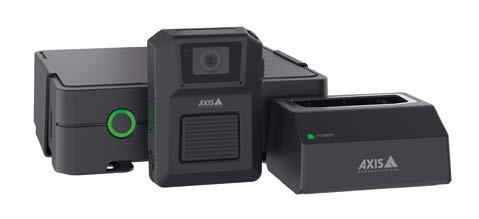
Open-platform
solutions.
body worn
Solutions that work with yours.
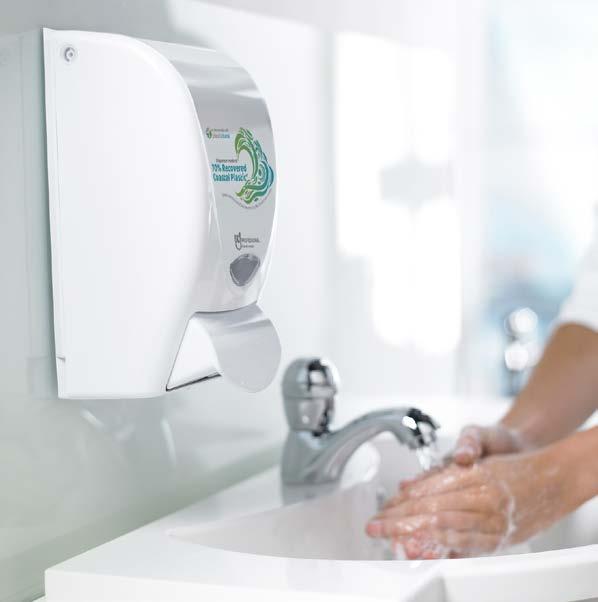
Sustainability should be visible
Visible sustainability efforts may improve people’s opinions of your campus
Considering the increased awareness surrounding plastic pollution, it comes as no surprise that the public is becoming more environmentally conscious; these shifting perceptions should influence our approach to campus management. A recent survey by SC
Johnson Professional revealed that noticeable sustainability initiatives could improve people’s opinions of an organisation and make them more likely to return.
To better understand how environmental sustainability considerations may affect UK consumer behaviours and
perceptions, SC Johnson Professional commissioned YouGov to survey a representative sample of consumers in the UK, with a total of 2,093 people responding.
Product choice is a key route to visibility. For those wanting to make their
38 | Winter 2023 | CAMPUS
SUSTAINABILITY
efforts more visible, the YouGov survey found that choosing products that reduce a company’s environmental impact to be one of the top ways it can show that it is taking steps to be more sustainable.
54% of respondents believed that businesses should demonstrate sustainability efforts through this route. For example, when looking at hand hygiene products, respondents stated that a focus on sustainability in the product’s manufacture is second only to a product’s features, such as its effectiveness and how pleasant it is to use.
Sustainability efforts should be visible.
When it comes to a company’s reputation, over half (55%) of the survey’s respondents said that environmental sustainability efforts improve their opinion of an organisation.
However, it is important that these efforts can be clearly seen; 57% of respondents said they are more likely to choose to return to a public facility if it is making visible and clear improvements to reduce the environmental impact of its operations.
When it comes to working environments, 24% of respondents said they are more likely to visit offices if they are taking clear steps to operate in an environmentally sustainable way. Whilst people often can’t choose the office they work in, they do have agency over which restaurants, cafes, or leisure centres they visit. In facilities such as these, where customers have more freedom to choose, the number who are more likely to visit a restaurant or shop if they are taking clear and visible steps to operate in an environmentally sustainable way grows to 47%.
Young people and women more likely to favour sustainability efforts. In general, the results of the SC Johnson Professional survey show that younger consumers tend to favour more sustainably conscious organisations. The younger the respondent, the more likely they are to choose to return to a public facility if it is making visible improvements to reduce the environmental impact of its operations (66% of 18–24-yearolds vs 53% of 55+).
Likewise, when asked to what extent, if at all, environmental sustainability efforts improve their opinion of an organisation, 70% of 18–24-year-olds said it would be improved versus 50% of those aged 55+. A further 53% of 18–24year-olds agreed that companies should demonstrate sustainability efforts even further by working with relevant charities or organisations. As the next generation of consumers

CAMPUS | Winter 2023 | 39

and workforce, it is important to recognise the behaviours, preferences, and values of younger respondents.
In addition to age, the SC Johnson Professional survey found female respondents to be more likely to consider the environment and sustainability in relation to questions asked about facilities. For example, women scored more likely to return to offices, and to visit cafes, restaurants, and leisure facilities if they are operated in a sustainable way. These findings align with data from the Office of National Statistics (ONS), which states that
Alan Macklin
women are more likely to make an environmentally conscious lifestyle change.
Demonstrate that your facility is making sustainable choices. Considering a move towards visible environmental sustainability efforts on your campus?
The SC Johnson Professional® Proline WAVE 1 litre washroom soap dispenser is made with 70% Recovered Coastal Plastic. The plastic is sourced from a global partnership between SC Johnson and Plastic Bank™, which adds social benefits by supporting opportunities
for over 20,000 people in vulnerable coastal areas.
Made with the equivalent of 16 x 500ml Recovered Coastal Plastic waste plastic bottles (excluding caps and labels), the Proline WAVE 1 litre dispenser can be used with the full range of SC Johnson Professional® foam soaps, which, compared with traditional lotion soaps, provide people with an effective, pleasant hand wash using up to 45% less water and 30% less product when washing and rinsing.
Head here to find out more
40 | Winter 2023 | CAMPUS

Inspirational learning environments
• Constructor (modular building supply) and main contractor (as required) that offers a full turnkey solution approach.
• Architecturally designed & inspirational learning environments. Our buildings can be visually indistinguishable from traditionally built schools.
• Utilising SEISMIC platform design and achieving a high level of PMV.
• Customised to client specifications and needs. From glazing to wall cladding finishes; even teaching spaces can be configured.
• Repeatable classroom designs, creating efficiency through standardisation. Standardisation is key to driving greater efficiency throughout all aspects of the project and delivery.
• We are recognised by a number of key frameworks, which are the DfE MMC1 LOT 1, CCS, NHS-SBS and the LHC.

Visit algeco.com for more information

Protecting night-time workers
Jason Petsch, CEO of OUTCO discusses how challenging work like winter gritting can be made safer through innovation
Over winter, we all feel that sense of battling the elements. Even if we’re not an outdoor worker taking on the weather, it’s hard to escape an oppressive sense of darker nights creeping in and of journeys to and from work without a glimpse of sunlight. Spare a thought then for the army of night-time workers that keep our country going. According to the
2022 census, a staggering 27% of the UK workforce describe themselves as a night-time workers whose main hours are during the evening or night. For our country to function at all, 8.7m of us are heading out to work while most are winding down. Given the antisocial hours involved, most of these roles are mission critical – crucial for maintaining complex supply chains or for guar-
anteeing round the clock emergency services. Yet despite this, it’s the nature of these roles that the better they’re done, the more invisible they are to the rest of us.
Winter gritting, snow and ice clearance exemplifies this invisible economy. We take it for granted that we can shop for last minute Christmas gifts without slipping and falling in icy car parks. Of course, the
42 | Winter 2023 | CAMPUS WINTER PLANNING
world is changing and today many of those shopping trips have been replaced by same day deliveries from Amazon. But in both cases, our convenience relies on the shopping car park or the online fulfilment centre’s loading bays being made safe and accessible. In other words, even an increasingly digitised word relies on manual labour: The knowledge that we can order from the comfort of our screen relies on a gritting team being despatched automatically, even before the frost is formed by an algorithmic process fed by real-time weather data.
When mission-critical functions are automatically triggered by machine intelligence this begs a question as to whether night-time workers are made even less visible. This is an increasingly important question as the adoption of digital technologies such as mobile apps, ’big data’ and increasingly AI, remove ever more layers of manual intervention and human supervision from everyday processes. The consulting group McKinsey has noted that the pressures of Covid-19 has
accelerated the pace of change to the degree that we have covered a “decade in days”. Consider how casually we make video calls or order a Deliveroo from our phone and it becomes evident how norms and expectations have changed with the same being true in industries such as outdoor facilities management.
Although the automation of winter maintenance doesn’t require clients to even request a gritting service, digitisation is allowing customers to immediately view in real-time when and where that service is delivered. In this context, big data’s impact isn’t just the increasingly accurate weather modelling that triggers services but it also comes into play in terms of providing real time monitoring of service delivery and in the ability to capture and analyse data retrospectively. As well as helping to optimise route planning and service delivery, this is critical in case of accidents on site as it provides site managers with legally defensible records. These reports demonstrate that they have fulfilled their duty of care to maintain site
safety. At OUTCO, these records are now incredibly detailed thanks to OUTCO’s bespoke mobile application used to provide precise GIS data that shows a clear ‘breadcrumb’ trail of where and when each operator has been on site.
All this provides an unexpected answer to the question posed above – in fact, night-time workers are becoming more visible in the digital age. Just consider our gritting teams. Even though they’re working in poor weather, in the dark, and at times in extreme conditions in remote locations – the ability to track their status in real time isn’t so much “Big Brother is watching” so much as providing them with the confidence that their team will always be immediately aware if issues arise. Rather than digitisation making individual workers more alienated, night-time and outdoor workers are actually becoming less isolated, with technology able to make their jobs easier and safer too. For example, when working in potentially dangerous conditions, having well maintained and checked equipment

CAMPUS | Winter 2023 | 43

is vital. Hence, before setting off for the night’s work or when starting work on a site, the same mobile app that schedules work and plans for our gritting teams requires them to complete pre-commencement vehicle checks, Point of Work risk assessments and fitness for work checks.
Digital technology like GPS is something we all take for granted but for teams working outdoors in poor visibility and adverse weather conditions, it can save time and stress by getting gritting vehicles to the right locations and ensure that teams grit the specific areas required. Similarly, operators can be alerted by their mobile devices if they’re gritting the wrong areas –helping save wasted materials and wasted effort.
From a personal perspective,
as CEO of OUTCO, I have a Duty of Care for the safety and welfare of our teams with the attendant responsibilities and liabilities clearly set out in legislation. As employers, digital technology provides a great deal of assurance and security to ensure we’re meeting our obligations. The same big data can also help prevent other risks and legal hazards like bad driving of company vehicles. As an aside, it can also help us meet ESG commitments by reducing environmental impacts, for example by cutting unnecessary journeys or gritting when and where it isn’t required. All businesses are increasingly scrutinising the supply chain impacts of their activities, e.g. Scope 3 greenhouse gas emissions. Having outdoor FM contractors able to provide this data on demand will come to matter even more. In other
words, as well as protecting people, better technology can help us better protect the environment too. It’s all part of being a responsible business.
Outdoor FM can involve demanding and even hazardous tasks carried out in the most unsociable and lonely hours. All too often we often see the dark side of progress, with new technology being used to wring out every last bit of productivity from employees. However, when we send people out to do the hardest tasks it’s vital that we place their well-being first and this is where innovation should really count.
For more information on how OUTCO can support your organisation this winter, contact www.outco.co.uk
44 | Winter 2023 | CAMPUS




s SMARTER PROTECTION MATTERS Fed up with false alarms...? Use our Cerberus PRO ASA technology and we will guarantee an end to them For fur ther details email: bpsales gb@siemens com www siemens co uk/cerberus The global leader in door opening solutions SMARTair ®, access control that cuts hassle and costs Download now our solution guide! campaigns.assaabloyopeningsolutions.eu/smartair-schools Improve security for the most valuable parts of your school


As Europe’s leading supplier, installer and integrator of digital television and audio visual equipment, Airwave can deliver your vision. With a presence in all key sectors including: healthcare, education, retail & leisure, stadia, prisons and transport, Airwave’s customer base is diverse.
www.airwave.tv

The ASSA ABLOY Group is the global leader in access solutions. Our offering covers products and services related to openings, such as locks, doors, gates and entrance automation solutions. This also includes expertise in controlling identities with keys, cards, tags, mobile and biometric identity verification systems.
www.assaabloy.com




Club Car boasts nearly 60 years of industry-leading innovation and design, initially focused on golf cars and then expanding to commercial utility vehicles and personal-use transportation.
www.clubcar.com





As the UK’s market-leading provider of technology led compliance and risk management solutions, our purpose is to help organisations be safer, healthier, and stronger. Our guide explains a range of measures and safety commitments so that universities are fully prepared and to keep the spread of the virus under control.
www.alcumusgroup.com
Buildings today don’t only provide a safe, functional place for people to live and work. They can also cater for – and even respond to – their needs, while helping them work more efficiently and sustainably. At Bosch Building Technologies, we are at the forefront of these new developments.
www.boschbuildingtechnologies.com
Our education solutions are developed from the ground up to increase campus security and safety while extending the capabilities of student, faculty and staff ID badges. Our solutions can be used for convenient access to buildings, computer login, cashless vending and campus activities.
www.hidglobal.com
Hysopt is unique design software that helps building managers get the most out of their heating and cooling systems. In collaboration with installation companies and engineering firms, we can cut your annual energy bill by 10 to 50%.
www.hysopt.com

LapSafe® created its first products to meet the needs of the education market and although we have since expanded into many other sectors, this remains our largest and most established area of expertise. Our products have been thoroughly tested by every type of education and academic institution
www.lapsafe.com
46 | Winter 2023 | CAMPUS
DIRECTORY



Originally founded in 1921, the company known today as Mitsubishi Electric has almost 100 years of experience in providing reliable, high quality products and support to installers, specifiers, corporate clients and general consumers all over the world.
https://les.mitsubishielectric.co.uk


From its inception in 2001, SALTO was created with one objective: to devise a world-class access control system that was simple to use and extremely efficient, giving users the ability to control all their access needs and secure all their doors without complex and expensive wiring.
www.saltosystems.com

As a trusted advisor and reliable partner, as a system integrator, service provider and a product vendor, Siemens offers energy-efficient, safe and secure buildings and infrastructure. With our people, our global footprint and our technical expertise, it's our passion helping you to create the perfect place – your perfect place.
www.siemens.com


Award-winning AV integrator, providing bespoke AV solutions with a strong company ethos, collegiality and partnership approach. Evolving with developments in AV technology allows Strive AV to deliver excellence across education, corporate, health and retail environments, providing AV solutions which transform communication and enhance end user’s experiences.
www.striveav.com






With more and more consideration being given to energy usage and the increasing implementation of green legislation, PumpSmart Limited is able to assist with the identification of areas where real energy savings can be made. New products, aimed at energy consumption reduction, are constantly entering the market with potential to improve existing installations.
www.pumpsmart.co.uk
We drive digital transformation by integrating world-leading process and energy technologies to realize the full efficiency and sustainability opportunities for your establishment. We provide end-point to cloud integration connecting products, controls, software and services.
https://www.se.com
Simpli-Fi are expert at helping educational establishments get the most out of wireless technology. We implement bespoke, reliable, scalable, flexible, and secure enterprise-grade, managed wireless networks that connect unlimited devices anywhere on site.
www.simpli-fi.co.uk
Veolia Water Technologies UK (VWT UK) is a leading water treatment solutions and services provider with a unique global presence and 160 years of experience. VWT UK strives to provide innovative solutions such as the new PURELAB Quest compact water purification unit that can generate Type I, II and III water.
www.veoliawatertechnologies.co.uk
CAMPUS | Winter 2023 | 47
Create a sustainable, high-performance university campus.
Discover how to maximize efficiency, safety, and productivity with an integrated university infrastructure.

Make the most of your energy
SM




















































































